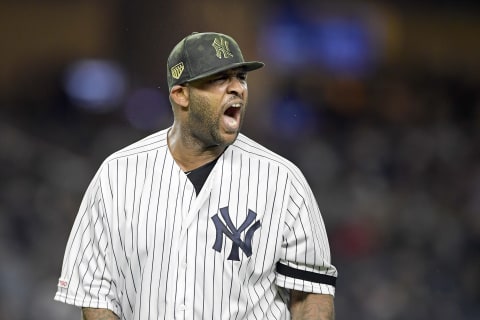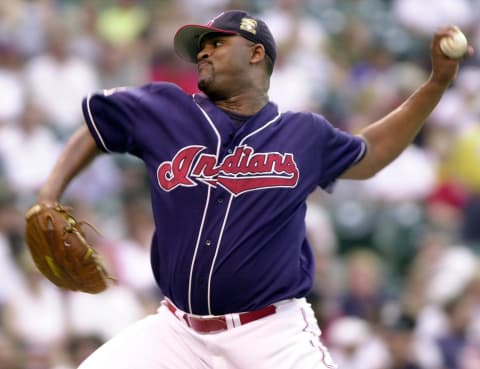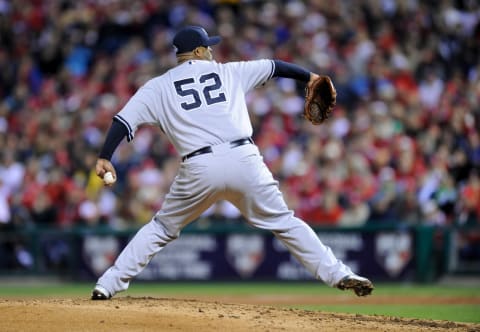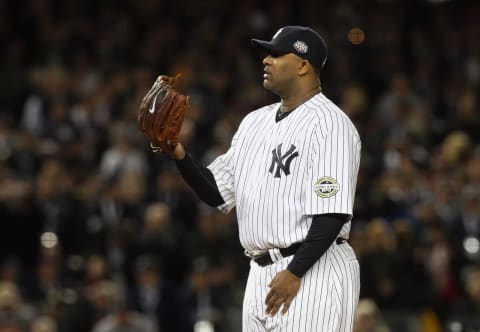Yankees: Does CC Sabathia Have A Hall of Fame “LegaCCy”?


On February 16, 2019, Yankees pitcher Sabathia announced that his 19-year MLB career will conclude following the current season.
A six-time All-Star, a three-time Warren Spahn Award winner, and one of just three left-handed starters in the 3000-strikeout club, Yankees LHP CC Sabathia has been widely hailed as one of the best starters of his generation and one of the greatest left-handed pitchers the game has ever seen. At the end of the 2024 season, Sabathia will have the opportunity to be eligible for the Hall of Fame. As his career draws to a close, I thought this might be a great time to look through the microscope at what Sabathia has accomplished in our beloved game and whether or not I believe he’s earned a place among the 2025 Cooperstown inductees.
Between 2001 and 2019, 453 starting pitchers reached qualifying status. If we go with the general “rule of thumb” that dictates Hall-of-Famers should be within the top 1.5% of all ballplayers, we can say that CC Sabathia should be firmly entrenched in the top six among starters for the span in which he played.
Now, if you’re looking at pure control dominance, Sabathia doesn’t look much like a Hall-of-Fame pitcher. His 7.74 K/9 ranks an unimpressive 125th out of 453 and his BB/9 of 2.76 is even lower at 177th. His 3.77 xFIP (77th among the qualifiers) tells a stronger, but still less-than-elite story.
Many of the “new wave” advanced metrics don’t favor pitchers like Yankees LHP CC Sabathia. Can the argument still be made, without the now-in-disrepute statistic of pitcher wins, that he deserves enshrinement?

A Case for CC Sabathia to the HOF (1/5)
First, let’s look at everyone’s favorite generalizing quantifier these days: Wins Above Replacement (WAR). From 2001-2019, Yankees LHP CC Sabathia was 2nd in the MLB in WAR among starting pitchers, and was just one of four to post a mark of 60+ (he totaled 66.2, trailing only Justin Verlander and ahead of more than two-dozen pitchers who have already entered the Hall of Fame).
In his career, he’s only had three total seasons in which he failed to post a WAR of 2.0 or better: 2014 (he pitched only eight games), 2015 (he battled alcohol addiction), and 2017 (injuries limited him to under 150 IP, but he still only finished 0.1-WAR short of the mark).
Sabathia was also one of the last of a breed of “workhorse” starters, a la Roy Halladay and the like. While only 13 starters since 2001 have started 400 or more games or pitched 2500+ innings, Sabathia laps the entire group, topping both lists at a staggering 545 starts and 3506.1 innings.
In an era in which the bullpen has risen to prominence, he sits 39th in innings pitched among qualified starting pitchers since 1923 (a group which includes 1715 players, placing him in the top 2.3%).
At least two relief pitchers being used by a team in a game has been the average since 1990 according to FiveThirtyEight, so the fact that he remains in the top 40 for a span that predates that timeframe by almost seven decades lends credence to what a true quality innings eater he has been throughout his career. He also finished 2nd to Roy Halladay in complete games since 2001 (38, a distant second place to Doc’s 65).

A Case for CC Sabathia to the HOF (2/5)
Yankees LHP CC Sabathia never had a year where he was indisputably the best pitcher in the game (though you can make an argument that his 2008 season outdid the three other pitchers who have legitimate cases for that year). What he was, was an elite starter who consistently gave you top-tier production.
He was in the top-four in his respective league in innings pitched each year from 2007-11. His K/9 had him in the top-nine in the AL eight different times. His FIP and ERA+ were each in the top-10 eight different times.
You may not be able to pinpoint a specific season wherein Sabathia absolutely dominated the league. That being said, if you take his body of work from the approximate middle-third of his career (2006-11), the separation becomes more apparent.
According to Fangraphs, 15 starters in that period of time posted a WAR between 20-32. Two stood head-and-shoulders above them: Roy Halladay and CC Sabathia.
As I mentioned before, Sabathia was never an elite strikeout machine. He did the basics, he just did them better than practically anyone else. He was ninth among qualifiers (204 starters) in WHIP, allowing just 1.16 baserunners per inning. It sounds dumb simple, and that’s because it really is.
His fastball was a top-20 velocity in the game, and his two other pitches moved so vastly different from his fastball and at such different speeds that the level of filth with which he was able to give batters fits on a consistent basis. According to Brooks Baseball, Sabathia would regularly be able to release all three of his main pitches somewhere between 6-6.5’ in the air.
His velocity separation would disrupt hitters’ timing. A four-seam was typically coming at 94.6-95.2 MPH. He would deliver his changeup anywhere between 86.7-87.6 MPH. His sliders were offered up at 81.2-83.2 MPH. He had about 7-9 MPH (10.3-13.2 ft/s) differentiation between his fastball and changeup, and 11-14 MPH (16.1-20.5 ft/s) split between the heater and his breaking ball.
This doesn’t sound like much, but when the ball is only going about 55 feet, it gives the batter a fraction of a second to determine whether to swing at one of three pitches that all look the same, but the timing discrepancy between which can vary anywhere from 0.187 seconds to double that at 0.374.
We also must give credit to Sabathia in the postseason, particularly his 2009 statistics in the Yankees’ last title run. He pitched at least 6.2 innings each time out, combined for a 1.98 ERA in his five starts, and played a pivotal role in the Yankees winning game four in order to take a 3-1 lead in the series despite pitching on only three days’ rest.

A Case for CC Sabathia to the HOF (3/5)
Additionally, Yankees LHP CC Sabathia’s ability to reinvent himself for a second wind after a battle with alcoholism that plagued his career (and more importantly, his life) for three years shows he didn’t just have physical “pitchability”; he had a high pitching IQ for the game.
After spending 2013-15 looking washed up, his fastball gone and allowing 10 H/9 and 1.4 HR/9, with a subpar 83 ERA+ (100 is average), a 4.81 ERA (4.40 FIP), and 1.40 WHIP, he has surged back since then with an 8.5 H/9 and 1.2 HR/9, 118 ERA+, 3.70 ERA (4.43 FIP), and 1.29 WHIP. He’s not nearly the dominant force he once was, but he has settled back in to be a very nice veteran option as a #4 starter.
Hall of Fame’s website dictates that any induction should factor in “player’s record, playing ability, integrity, sportsmanship, character, and contributions to the team(s) on which the player played.”
To be able to recover from serious addiction, reinvent himself as a man and secondarily as a pitcher at the age of 35 without the fastball that used to be his bread and butter, adding a cutter to his arsenal with the help of former teammate Andy Pettitte, and do all of this under the intense scrutiny of New York media, takes a mental sharpness, self-awareness, integrity, commitment, and skill. Already, we’ve established all but one of the criteria listed above.

A Case for CC Sabathia to the HOF (4/5)
What about the contributions to his individual teams?
Well, on a 2001-08 Indians team that won just a single playoff series in CC Sabathia’s time there, he was arguably the only consistently elite pitcher that the Indians had. Behind his 30.3 WAR, the second-best mark by an Indians pitcher over that stretch was 14.9 by Cliff Lee – less than half of what Sabathia posted.
When he spent half a season with the Brewers in 2008, he tied Ben Sheets with a team-leading 4.7 WAR despite making 14 fewer starts throughout his brief time in Milwaukee. His 1.65 ERA, 2.44 FIP, 8.82 K/9, 1.72 BB/9, 0.41 HR/9, and 1.00 WHIP were also each tops in their respective categories among Brewers starters in 2008, despite his only playing a fraction of the season with the team.
For the Yankees, it’s been the same story ever since. One of Luis Severino or Masahiro Tanaka could pass him in a few years, but for now, his 31.3 WAR from 2009-2019 is nearly double the second-place finisher on the list of Yankees starters (Tanaka has posted 16.4). Thusly, having been his team’s premier rotation option for each of his three employers, I contend that Sabathia also has locked in this last criterion.

A Case for CC Sabathia to the HOF (5/5)
Sabathia is also one of the premier left-handed starters of all-time. I would argue there are two names who can definitively be claimed as superior to CC: Lefty Grove, Randy Johnson. Other elite names like Carl Hubbell, Eddie Plank, Warren Spahn, Tom Glavine, and Steve Carlton – you can make a compelling case that Sabathia is better than each of these players.
More from Call to the Pen
- Philadelphia Phillies, ready for a stretch run, bomb St. Louis Cardinals
- Philadelphia Phillies: The 4 players on the franchise’s Mount Rushmore
- Boston Red Sox fans should be upset over Mookie Betts’ comment
- Analyzing the Boston Red Sox trade for Dave Henderson and Spike Owen
- 2023 MLB postseason likely to have a strange look without Yankees, Red Sox, Cardinals
Sabathia tops Glavine in K/9+, BB/9+, FIP- (one of the most-utilized park-adjusted metrics for comparing pitchers across generations), WHIP+, BAA+, and ERA-. Every major park-adjusted pitching quantifier you can think of, Sabathia’s is superior to Glavine’s. Hubbell comes off too: he allowed the most home runs in all of baseball from 1928-1943, a timeframe that wasn’t known for players’ ability to hit the long ball. Even if you just factor in his HR/9, to eliminate the argument that he also pitched more innings in that stretch than any other pitcher, he still comes out squarely in the bottom-third among MLB starters.
You can make the argument that CC’s Hall of Fame case does not come without cracks. A lack of standalone dominance in any given season, low strikeout rate relative to the era in which he pitched, less-than-elite ERA, among others.
Some will argue that CC became a shoo-in, guaranteed instantly for induction, by achieving his 3000th strikeout earlier this season, despite the fact that three of the eight pitchers just below him on the all-time list were not voted into Cooperstown, even with a strikeout difference of less than 400 between them and the 3000 mark. Sabathia’s next win, for those who still believe in the individual statistic for pitchers, will be his 250th. He would be 48th on the all-time list, with all but nine of the players ahead of him currently having Hall of Fame status.
Next. Why the Yankees Should Steer Clear of Max Scherzer. dark
On these and additional grounds, I believe Sabathia’s case should relatively easily push voters in the direction of affirming his right to join the veritable pantheon of all-time baseball greats. Will the writers agree? We shall CC.